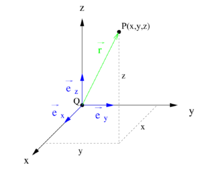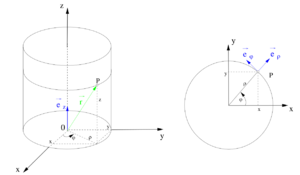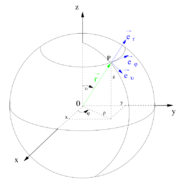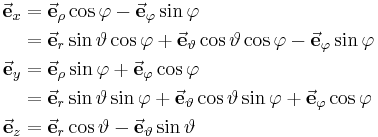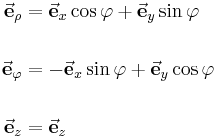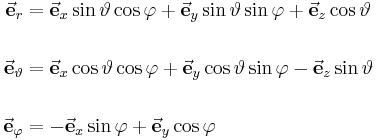Formelsammlung Koordinatensysteme: Unterschied zwischen den Versionen
Aus GET A
| (14 dazwischenliegende Versionen von 3 Benutzern werden nicht angezeigt) | |||
| Zeile 10: | Zeile 10: | ||
[[Kugelkoordinaten]] | [[Kugelkoordinaten]] | ||
|- | |- | ||
| − | |style="background-color:#dde6f3;"| | + | |style="background-color:#dde6f3;"| |
| + | |style="background-color:#c9d7ec;text-align:center;"| | ||
| + | [[Datei:Kartesische Koordinaten.png|200px|miniatur|center]] | ||
| + | |style="background-color:#dde6f3;text-align:center;"| | ||
| + | [[Datei:Zylinderkoordinaten.png|300px|miniatur|center]] | ||
| + | |style="background-color:#c9d7ec;text-align:center;"| | ||
| + | [[Datei:Kugelkoordinaten.png|180px|miniatur|center]] | ||
| + | |- | ||
| + | |style="background-color:#dde6f3;"| | ||
| + | Wertebereiche der Koordinaten | ||
| + | |style="background-color:#c9d7ec;text-align:center;"| | ||
| + | <math>P=P(x,y,z)</math><br> | ||
| + | <math>-\infty\leq x\leq\infty</math><br> | ||
| + | <math>-\infty\leq y\leq\infty</math><br> | ||
| + | <math>-\infty\leq z\leq\infty</math> | ||
| + | |style="background-color:#dde6f3;text-align:center;"| | ||
| + | <math>P=P(\rho,\varphi,z)</math><br> | ||
| + | <math>0 \leq \rho \leq\infty</math><br> | ||
| + | <math>0 \leq \varphi < 2\pi</math><br> | ||
| + | <math>-\infty \leq z \leq\infty</math> | ||
| + | |style="background-color:#c9d7ec;text-align:center;"| | ||
| + | <math>P=P(r,\vartheta,\varphi)</math><br> | ||
| + | <math>0\leq r\leq\infty</math><br> | ||
| + | <math>0\leq \vartheta\leq\pi</math><br> | ||
| + | <math>0\leq \varphi < 2\pi</math> | ||
| + | |- | ||
| + | |style="background-color:#dde6f3;"| | ||
| + | [[Einheitsvektoren]] | ||
|style="background-color:#c9d7ec;text-align:center;"| | |style="background-color:#c9d7ec;text-align:center;"| | ||
<math>\vec{\mathbf{e}}_x,\vec{\mathbf{e}}_y,\vec{\mathbf{e}}_z</math> | <math>\vec{\mathbf{e}}_x,\vec{\mathbf{e}}_y,\vec{\mathbf{e}}_z</math> | ||
| Zeile 23: | Zeile 50: | ||
|style="background-color:#c9d7ec;text-align:center;"| | |style="background-color:#c9d7ec;text-align:center;"| | ||
<math>\begin{align} | <math>\begin{align} | ||
| − | \vec{\mathbf{e}}_x\times\vec{\mathbf{e}}_y &=\vec{\mathbf{e}}_z | + | \vec{\mathbf{e}}_x\times\vec{\mathbf{e}}_y &=\vec{\mathbf{e}}_z\\ |
| − | \vec{\mathbf{e}}_y\times\vec{\mathbf{e}}_z &=\vec{\mathbf{e}}_x | + | \vec{\mathbf{e}}_y\times\vec{\mathbf{e}}_z &=\vec{\mathbf{e}}_x\\ |
\vec{\mathbf{e}}_z\times\vec{\mathbf{e}}_x &=\vec{\mathbf{e}}_y | \vec{\mathbf{e}}_z\times\vec{\mathbf{e}}_x &=\vec{\mathbf{e}}_y | ||
\end{align}</math> | \end{align}</math> | ||
|style="background-color:#dde6f3;text-align:center;"| | |style="background-color:#dde6f3;text-align:center;"| | ||
<math>\begin{align} | <math>\begin{align} | ||
| − | \vec{\mathbf{e}}_{\rho}\times\vec{\mathbf{e}}_{\varphi} &=\vec{\mathbf{e}}_z | + | \vec{\mathbf{e}}_{\rho}\times\vec{\mathbf{e}}_{\varphi} &=\vec{\mathbf{e}}_z\\ |
| − | \vec{\mathbf{e}}_{\varphi}\times\vec{\mathbf{e}}_z &=\vec{\mathbf{e}}_{\rho} | + | \vec{\mathbf{e}}_{\varphi}\times\vec{\mathbf{e}}_z &=\vec{\mathbf{e}}_{\rho}\\ |
\vec{\mathbf{e}}_z \times\vec{\mathbf{e}}_{\rho} &=\vec{\mathbf{e}}_{\varphi} | \vec{\mathbf{e}}_z \times\vec{\mathbf{e}}_{\rho} &=\vec{\mathbf{e}}_{\varphi} | ||
\end{align}</math> | \end{align}</math> | ||
|style="background-color:#c9d7ec;text-align:center;"| | |style="background-color:#c9d7ec;text-align:center;"| | ||
<math>\begin{align} | <math>\begin{align} | ||
| − | \vec{\mathbf{e}}_r\times\vec{\mathbf{e}}_{\vartheta} &= \vec{\mathbf{e}}_{\varphi} | + | \vec{\mathbf{e}}_r\times\vec{\mathbf{e}}_{\vartheta} &= \vec{\mathbf{e}}_{\varphi}\\ |
| − | \vec{\mathbf{e}}_{\vartheta}\times\vec{\mathbf{e}}_{\varphi} &= \vec{\mathbf{e}}_r | + | \vec{\mathbf{e}}_{\vartheta}\times\vec{\mathbf{e}}_{\varphi} &= \vec{\mathbf{e}}_r\\ |
\vec{\mathbf{e}}_{\varphi}\times\vec{\mathbf{e}}_r &= \vec{\mathbf{e}}_{\vartheta} | \vec{\mathbf{e}}_{\varphi}\times\vec{\mathbf{e}}_r &= \vec{\mathbf{e}}_{\vartheta} | ||
\end{align}</math> | \end{align}</math> | ||
| Zeile 81: | Zeile 108: | ||
\end{align}</math> | \end{align}</math> | ||
|- | |- | ||
| − | |style="background-color:#dde6f3"|Ortsvektor | + | |style="background-color:#dde6f3"|[[Ortsvektor]] |
|style="background-color:#c9d7ec;text-align:center;"| | |style="background-color:#c9d7ec;text-align:center;"| | ||
<math>\vec{\mathbf{r}}=\vec{\mathbf{e}}_x x+\vec{\mathbf{e}}_y y+\vec{\mathbf{e}}_z z</math> | <math>\vec{\mathbf{r}}=\vec{\mathbf{e}}_x x+\vec{\mathbf{e}}_y y+\vec{\mathbf{e}}_z z</math> | ||
| Zeile 128: | Zeile 155: | ||
<math>\mathrm{d}\vec{\mathbf{A}}=\vec{\mathbf{e}}_r r^2\sin\vartheta\mathrm{d}\vartheta\mathrm{d}\varphi</math> | <math>\mathrm{d}\vec{\mathbf{A}}=\vec{\mathbf{e}}_r r^2\sin\vartheta\mathrm{d}\vartheta\mathrm{d}\varphi</math> | ||
|} | |} | ||
| + | |||
| + | <noinclude>==Literatur== | ||
| + | * Manfred Albach, ''Grundlagen der Elektrotechnik 1: Erfahrungssätze, Bauelemente, Gleichstromschaltungen'', 3. Auflage (Pearson Studium, 2011) | ||
| + | </noinclude> | ||
| + | |||
| + | [[Kategorie:Artikel]] | ||
| + | [[Kategorie:Feedback]] | ||
Aktuelle Version vom 25. Oktober 2023, 16:34 Uhr
|
Wertebereiche der Koordinaten |
|
|
|
|
|
|
| |
|
|
|
| |
|
Zusammenhang zu kartesischen Koordinaten |
|
| |
| Umrechnungen |
|
|
|
| Ortsvektor |
|
|
|
| Betrag des Ortsvektors |
|
|
|
| vektorielles Wegelement |
|
|
|
| Volumenelement |
|
|
|
| vektorielles Flächenelement |
|
|
|
Literatur
- Manfred Albach, Grundlagen der Elektrotechnik 1: Erfahrungssätze, Bauelemente, Gleichstromschaltungen, 3. Auflage (Pearson Studium, 2011)
